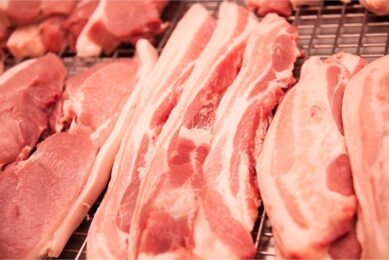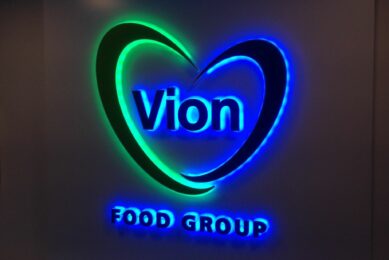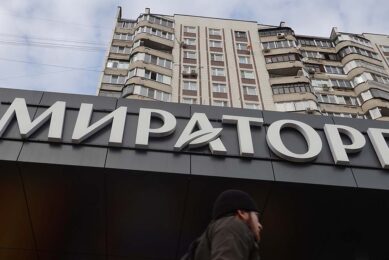Zhongpin: Higher results for Q1

Zhongpin Inc., a meat and food processing company in the People’s Republic of China, reported higher revenues, net income, and diluted earnings per share for the first quarter of 2010 compared with the first quarter of 2009.
©©© First Quarter 2010 and recent highlights:
©©© — Net sales revenues increased 32.8 percent in the three months ended
©©©©©© March 31, 2010 to $204.3 million from $153.8 million in the first
©©©©©© quarter 2009.
©©© — Net income increased 37.1 percent to $13.3 million in the first quarter
©©©©©© 2010 from $9.7 million in the first quarter 2009.
©©© — Basic and diluted earnings per share increased 15.2 percent to $0.38 in
©©©©©© the first quarter 2010 from $0.33 in the first quarter 2009.
©©© — Hog and pork prices in the first quarter 2010 decreased about 10
©©©©©© percent from the fourth quarter 2009 due mainly to the hog supply
©©©©©© temporarily exceeding market demand. Prices are expected to recover in
©©©©©© the near future.
©©© — In March 2010, Zhongpin started to expand its pork plant in Anyang to
©©©©©© add 35 percent more capacity for chilled pork; the expansion should be
©©©©©© completed in July.
©©© — The company opened its new premium pork oil plant in Changge on April
©©©©©© 12, with a designed annual capacity of 20,000 metric tons of oil.
©©© — Prior guidance for the year 2010 has been maintained.
©
©
Mr. Xianfu Zhu, Chairman and Chief Executive Officer of Zhongpin Inc., said, “Our first quarter of 2010, I believe, proves the wisdom of our aggressive expansion, since we were able to continue growing sales revenues, net income, and earnings per share during a period of moderate but temporary declines in the prices of hogs and pork.”
©
“Our long-term strategy, established several years ago and only slightly retuned, continues to be (1) increase production capacity, (2) broaden awareness and recognition of our well-known brand, which today is starting to emerge from a regional toward a national market, (3) exploit our sales capabilities by accessing more retail outlets and sales channels, and as a result, (4) increase sales revenues and net income.”
©
Capacity and market expansion
Mr. Zhu added, “In 2010, we will continue to execute our strategic plan, which has proven to be successful so far in sustaining our growth. The easiest actions to see are our plant expansions.”
In January 2010, we began production in our new chilled and frozen pork plant in Tianjin. It has an annual capacity of 100,000 metric tons, of which 70 percent will be chilled pork and 30 percent frozen pork. We believe we will reach target capacity utilization in this plant during the third quarter 2010.
©
In March 2010, we began to improve our chilled pork plant in Anyang to expand capacity by 35 percent. When the four-month project is completed in July, our annual capacity there will be 85,000 metric tons, of which 70 percent will be for chilled pork, up from 60 percent, and the remaining 30 percent will be for frozen pork, which remains unchanged in capacity. Production will be maintained during the changes. The improvements and capacity increase are expected to help meet the rapidly growing demand for high quality chilled pork that we expect in north China over the next several years.
©
In April 2010, we started constructing a new prepared pork products plant in Tianjin that will have an annual capacity of about 36,000 metric tons. The new Tianjin facility will include a new warehouse and distribution center and a research and development center, which should improve our product portfolio, support our cold-chain logistics, and help accommodate the higher production capacity by facilitating efficient distribution. Production is expected to start in the fourth quarter 2010 and should achieve target capacity utilization in the second quarter 2011. The two state-of-the-art Tianjin facilities that will be added in 2010, which will be integrated within one industrial park, are expected to cost about $61.0 million in total.
©
As expected, we opened our new premium pork oil production plant in Changge on April 12. It has a designed annual capacity of about 20,000 metric tons. This new product is being sold through Zhongpin’s existing sales channels to institutional, wholesale, and retail customers. The first orders filled have been under contracts with institutional and wholesale customers that were signed before production began.
By the end of 2010, we believe that Zhongpin’s annual capacity will be at least 563,760 metric tons for chilled and frozen pork, 126,000 metric tons for prepared pork products, 20,000 metric tons for premium pork oil, and 30,000 metric tons for vegetables and fruits, for a total production capacity of 739,760 metric tons. Of course, as we build additional plants, we also extend our cold-chain logistics system for delivery into our new markets.
©
New cold storage and distribution centers
Zhongpin is also constructing three cold storage and distribution centers for chilled and fresh pork and agricultural products. The centers are located adjacent to Zhongpin’s processing facilities in Zhumadian, Anyang, and Luoyang, in China’s Henan province, and will begin operating in the second quarter 2010. Total investment for the centers will be $13.6 million.
©
Each center will have more than 20,000 square meters for processing, storage, and allocation workshops. Adjustable multi-temperature multi-level cold storage rooms in each center will provide outstanding conditions to maintain the highest quality and flavor for a variety of products. Initially, about 40 percent of the capacity will be devoted to Zhongpin’s chilled and frozen pork, with the remaining 60 percent used to provide storage, processing, and allocation services for other food producers, most of which are already under contract. As with Zhongpin’s other new facilities, the centers will have the most modern quality assurance, processing, logistics, and information technology systems.
©
Technology and training leverage
Our research and development is focused mainly on advancing process technology for our production and on creating new products to serve the country’s growing need for tasteful, healthy, and nutritious food that can be easily adopted in China’s evolving modern way of life.
We also continue to invest in training and employee development so that we can better sustain rapid and healthy growth while maintaining a satisfactory profit margin.
©
Further emphasis on chilled pork and prepared pork products
Our most popular products are chilled pork and prepared pork products. Chilled pork offers customers the most preferred taste, while prepared pork products offer great and varied tastes, combined with easy and quick preparation. We believe these two product lines, in particular, should provide us with attractive profit margins and high sustainable demand.
©
Hog and pork prices declined
Hog and pork prices decreased approximately 10 percent in the first quarter of 2010 from the fourth quarter of 2009 primarily because the supply of hogs was higher than the market demand. The imbalance between supply and demand was due to a limited outbreak of foot and mouth disease in south China that affected the hog breeding industry. Zhongpin does not source hogs from south China. As of the end of the first quarter, we are not aware of any reports of new infections, so we believe the disease has been controlled and the outbreak is over. We expect hog and pork prices to recover in the near future.
©
Outlook for pork demand in China
China’s economy continues to expand at a good rate, with pork at the top of the food buying list as China’s preferred protein. The industry outlook for pork processing remains positive. Zhongpin’s brand position and higher market share in the pork category continues to strengthen, and we are broadening into additional geographic markets and new products based on our research and development. The expansion of our processing plants and distribution networks is giving us the ability to satisfy the increasing market demand for our high quality products.
Mr. Zhu summarized, “With this good start for the year, we believe our outlook for 2010 continues to be encouraging, and we remain comfortable with our previous performance guidance.”
©
Guidance maintained
Zhongpin is maintaining its prior guidance for the year 2010.
Mr. Warren Wang, Zhongpin’s Chief Financial Officer, said, “For the year 2010, we continue to believe that Zhongpin’s sales revenues should be within a range of $900 million to $940 million, with gross profit within the range of $106 million to $115 million and net income within the range of $52 million to $57 million. The resulting diluted earnings per share for the year 2010 is currently expected to be within the range of $1.49 to $1.64 per share.”
©©© This guidance is based on several assumptions and strategies that include:
©©© — Continuation of China’s policies designed to stimulate domestic
©©©©©© consumption and economic growth;
©©© — Higher average pork prices in China’s pork industry in 2010 than in
©©©©©© 2009;
©©© — Higher sales volume of our pork products, led by chilled pork products,
©©©©©© followed by prepared pork products and frozen pork products;
©©© — A higher percentage of sales from our higher-margin chilled pork and
©©©©©© prepared pork products;
©©© — Average capacity utilization of about 75 percent for pork products;
©©© — Increasing distribution efficiencies from expansion of our cold-chain
©©©©©© logistics system and service areas;
©©© — Growing awareness of the Zhongpin brand in regional markets and
©©©©©© emerging brand awareness across China; and
©©© — Continuation of the Chinese government’s support and subsidies for
©©©©©© producers of agricultural products, such as Zhongpin.
©
Zhongpin believes that China’s food processing industry will continue to consolidate, which may result in higher market shares for our main competitors. However, we believe Zhongpin is equipped to meet the challenge of increasing competition and that our guidance for 2010 can be achieved.
©
Sales revenues
Total revenues increased $50.5 million or 32.8 percent to $204.3 million in the three months ended March 31, 2010 from $153.8 million in the three months ended March 31, 2009. The increase was primarily due to higher sales volume of our pork and pork products, which was partly offset by somewhat lower prices for our pork and pork products.
The following table shows our sales by product division for the three months ended March 31, 2010 and 2009.
©
©
Chilled pork revenues increased on higher tonnage at lower average prices. Revenues from chilled pork products increased 32.9 percent in the first quarter 2010 from the first quarter 2009. Chilled pork tonnage increased 48.1 percent in the first quarter 2010 from the first quarter 2009. Our average price per metric ton for chilled pork decreased 10.2 percent in the first quarter 2010 from the first quarter 2009.
©
Frozen pork revenues increased on higher tonnage at lower average prices. Revenues from frozen pork products increased 14.5 percent in the first quarter 2010 from the first quarter 2009. Frozen pork tonnage increased 36.4 percent in the first quarter 2010 from the first quarter 2009. Our average price per metric ton for frozen pork decreased 16.0 percent in the first quarter 2010 from the first quarter 2009.
©
Prepared pork revenues increased on higher tonnage at slightly lower average prices. Revenues from prepared pork products increased 65.0 percent in the first quarter 2010 from the first quarter 2009. Prepared pork tonnage increased 68.4 percent in the first quarter 2010 from the first quarter 2009. Our average price per metric ton for prepared pork products decreased 2.0 percent in the first quarter 2010 from the first quarter 2009.
©
Pork and pork products totaled 98.6 percent of total revenues in the first quarter 2010, compared with 99.0 percent of total revenues in the first quarter 2009.
©
Vegetables and fruits revenues increased on higher tonnage at higher average prices. Vegetables and fruits revenues increased 93.3 percent in the first quarter 2010 from the first quarter 2009. Tonnage of vegetables and fruits increased 49.4 percent in the first quarter 2010 from the first quarter 2009. Our average price per metric ton for vegetables and fruits increased 29.5 percent in the first quarter 2010 from the first quarter 2009. This product division benefitted from strong export sales in the first quarter 2010 compared with the first quarter 2009.
©
Vegetables and fruits were 1.4 percent of total revenues in the first quarter 2010 compared with 1.0 percent of total revenues in 2009.
©
The sales of meat and vegetable products are closely related to the particular regional markets in which our distribution channels are located. Therefore, the increase in metric tons sold for the first quarter of 2010 was partly attributable to our success in expanding our distribution channels. The following table shows our distribution channels at the end of the first quarters of 2010 and 2009.
©
©
©
©
The increase in sales to different distribution channels was mainly due to the following factors: (1) our production capacity has increased since we put new facilities into operation in 2009 and increased our utilization rate for all facilities; (2) we have built up our brand image and brand recognition through general advertising display promotions and sales campaigns; (3) we have increased the number of stores and other channels through which we sell our products; and (4) we believe consumers are placing increased importance on food safety and are willing to pay higher prices for safe food products.
As presented in the table above, our most significant dollar revenue increases came almost equally from our retail channels, wholesalers and distributors, and restaurants and food service organizations. Sales to restaurants and food service providers had the highest percentage increase.
Revenues from export sales increased $0.8 million or 160.0 percent to $ 1.3 million in the first quarter 2010 from $ 0.5 million in the first quarter 2009. The increase was mainly in vegetables and fruits.
©
Costs of sales and gross profit margin
©
Our cost of sales increased $44.7 million or 33.2 percent to $179.4 million in the first quarter 2010 from $134.7 million in the first quarter 2009. The increase in our cost of sales was consistent with our increase in
sales revenues.
©
Our gross profit margin (gross profit divided by sales revenues) decreased slightly to12.2 percent in the first quarter 2010 from 12.4 percent in the first quarter 2009 primarily due to (1) an increase in labor costs, (2) an increase in depreciation expense resulting from the newly-built production facilities that were put into service in the past year, and (3) our strategic decision to take actions to increase market share and our capacity utilization rate.
©
As a result, our gross profit margin was lower than the level we would expect to achieve when we fully integrate our new production facilities and open new regional markets for our products. We intend to adjust our production levels and product mix and the percentages of our sales through our different sales channels in the coming quarters to increase our gross profit margin.
©
Join 18,000+ subscribers
Subscribe to our newsletter to stay updated about all the need-to-know content in the pigsector, three times a week. Beheer
Beheer










 WP Admin
WP Admin  Bewerk bericht
Bewerk bericht